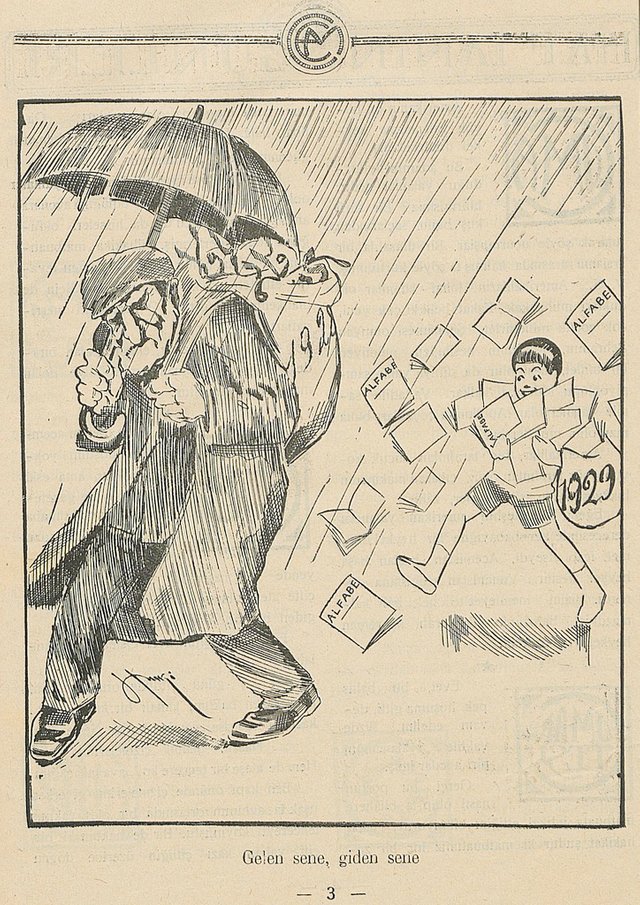47. Today in 1920s Turkey: 3 January 1929 (A New Alphabet for the New Year)

(Cartoon, Cem, 3 January 1929, no. 37, page 3.)
English:
The incoming year, the outgoing year.
Comments:
Unlike most of the cartoons and articles posted under “Today in 1920s Turkey,” this example has little Ottoman text to speak of, indeed, it was not even necessary to include the usual Türkçe transcription to accompany the English translation. The reason for this is that the present cartoon was published after alphabet reform which was passed on 1 November 1928 and enforced in the print media at the end of the year, as of 1 December 1928. As such, the advent of alphabet reform and the arrival of the New Year seemed to happen almost simultaneously. The present cartoon effectively conflates these two near-concurrent events to illustrate the overarching theme of renewal.
A modern viewer unfamiliar with the history or Turkey (or alphabet reform in particular) can deduce the basic details of “alphabet reform” merely by deciphering the cartoon's rather straightforward imagery:
- There is a child representative of novelty and renewal energetically bouncing into the frame as an old, hunched over man slowly exits to the left. This old man represents age, decay, and obsolescence.
- The child’s bag further drives home the fact that he symbolizes the New Year as the number 1929 is conspicuously displayed upon it. The old man’s bag, on the other hand, is labeled with 1928, the recently retired year. These transitioning dates are even more relevant in the context of the publication’s release date just three days into 1929. Since the journal Cem only published once per week on Thursdays at this time their “New Year” edition was not released until 3 January.
- As a symbol of the hopping and bopping New Year, the young lad tosses about booklets for learning the new Turkish alphabet that was devised and accepted by the revolutionary government. The word Alfabe or “Alphabet” appears on the books in the new Latinized Turkish letters. By contrast, unlike the young boy disseminating knowledge, the old man of 1928 is quietly removing his obsolete hoard of Arabic letters which represents the script of the old Ottoman order—the script rejected by the Republican government.
- Furthermore, the facial expressions of the two characters contribute to the contrast between new and obsolete; young and old; incoming and outgoing established in the cartoon as the young boy sports a shining smile while the old man appears troubled and unhappy.
- And finally, even the weather is envisioned by the cartoonist as responding positively to the young boy (aka 1929) who somehow avoids getting drenched. The same cannot be said of the old man (aka 1928) who, in addition to carrying his heavy load on his aging back, must hold an umbrella over himself to protect from the heavy rain falling from above.
For more details concerning alphabet reform and its nation-wide implementation over the course of Fall and Winter of 1928 I invite you to view the following relevant posts:
#29: Happy Republic Day, Turkey!